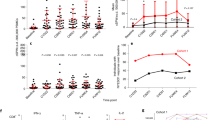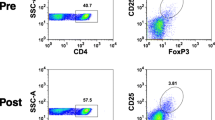Abstract
The use of whole cell tumor vaccines and various means of loading antigen onto dendritic cells have been under investigation for over a decade. Induction of apoptosis and the exposure of immune-stimulating proteins are thought to be beneficial for the use in immunotherapy protocols, but conclusive evidence in the clinical setting has been lacking. Incubation of melanoma cell lines with interferon-gamma (IFN-γ) increased phosphatidylserine and calreticulin exposure, but not in the IFN-γ-resistant cell line Lu-1205. Short-term autologous melanoma cell lines used for loading dendritic cells for immunotherapy showed differential response to the pro-apoptotic effects of IFN-γ. These IFN-γ-treated tumor cells (TCs) were irradiated and used for loading antigen for dendritic cell therapy. A log-rank comparison of survival for patients whose TCs were found to be either sensitive (upregulated phosphatidylserine and calreticulin) or insensitive to IFN-γ revealed a strongly significant correlation to progression-free (p = 0.003) and overall survival (p = 0.002) favorably in those patients whose cell lines were resistant to the proapoptotic effect of IFN-γ. These results suggest that the use of IFN-γ in anti-melanoma dendritic cell-based immunotherapy may only be beneficial when the cells do not undergo apoptosis in response to IFN-γ and support the contention that the use of some apoptotic cells in vaccines may be detrimental.




Similar content being viewed by others
References
Palucka AK, Ueno H, Fay JW, Banchereau J (2007) Taming cancer by inducing immunity via dendritic cells. Immunol Rev 220:129–150
Tuyaerts S, Aerts JL, Corthals J, Neyns B, Heirman C, Breckpot K et al (2007) Current approaches in dendritic cell generation and future implications for cancer immunotherapy. Cancer Immunol Immunother 56:1513–1537
Cranmer LD, Trevor KT, Hersh EM (2004) Clinical applications of dendritic cell vaccination in the treatment of cancer. Cancer Immunol Immunother 53:275–306
Dillman RO, Selvan SR, Schiltz PM (2006) Patient-specific dendritic-cell vaccines for metastatic melanoma. N Engl J Med 355:1179–1181
Dillman RO, Nayak SK, Barth NM, DeLeon C, Schwartzberg LS, Spitler LE et al (1998) Clinical experience with autologous tumor cell lines for patient-specific vaccine therapy in metastatic melanoma. Cancer Biother Radiopharm 13:165–176
Meyskens FL Jr, Kopecky KJ, Taylor CW, Noyes RD, Tuthill RJ, Hersh EM et al (1995) Randomized trial of adjuvant human interferon gamma versus observation in high-risk cutaneous melanoma: a Southwest Oncology Group Study. J Natl Cancer Inst 87:1710–1713
Lotem M, Machlenkin A, Hamburger T, Nissan A, Kadouri L, Frankenburg S et al (2009) Autologous melanoma vaccine induces antitumor and self-reactive immune responses that affect patient survival and depend on MHC class II expression on vaccine cells. Clin Cancer Res 15:4968–4977
Fujisawa Y, Nabekura T, Nakao T, Nakamura Y, Takahashi T, Kawachi Y et al (2009) The induction of tumor-specific CD4+ T cells via major histocompatibility complex class II is required to gain optimal anti-tumor immunity against B16 melanoma cell line in tumor immunotherapy using dendritic cells. Exp Dermatol 18:396–403
Zoller M, Strubel A, Hammerling G, Andrighetto G, Raz A, Ben-Ze’ev A (1988) Interferon-gamma treatment of B16 melanoma cells: opposing effects for non-adaptive and adaptive immune defense and its reflection by metastatic spread. Int J Cancer 41:256–266
Ugurel S, Seiter S, Rappl G, Stark A, Tilgen W, Reinhold U (1999) Heterogenous susceptibility to CD95-induced apoptosis in melanoma cells correlates with bcl-2 and bcl-x expression and is sensitive to modulation by interferon-gamma. Int J Cancer 82:727–736
Ullrich E, Bonmort M, Mignot G, Kroemer G, Zitvogel L (2008) Tumor stress, cell death and the ensuing immune response. Cell Death Differ 15:21–28
Sporri R, Reis e Sousa C (2005) Inflammatory mediators are insufficient for full dendritic cell activation and promote expansion of CD4+ T cell populations lacking helper function. Nat Immunol 6:163–170
Obeid M, Panaretakis T, Joza N, Tufi R, Tesniere A, van Endert P et al (2007) Calreticulin exposure is required for the immunogenicity of gamma-irradiation and UVC light-induced apoptosis. Cell Death Differ 14:1848–1850
Fry TJ, Shand JL, Milliron M, Tasian SK, Mackall CL (2009) Antigen loading of DCs with irradiated apoptotic tumor cells induces improved anti-tumor immunity compared to other approaches. Cancer Immunol Immunother 58:1257–1264
Obeid M, Tesniere A, Ghiringhelli F, Fimia GM, Apetoh L, Perfettini JL et al (2007) Calreticulin exposure dictates the immunogenicity of cancer cell death. Nat Med 13:54–61
Del Cid N, Jeffery E, Rizvi SM, Stamper E, Peters LR, Brown WC et al (2010) Modes of calreticulin recruitment to the major histocompatibility complex class I assembly pathway. J Biol Chem 285:4520–4535
Su Q, Wang S, Baltzis D, Qu LK, Raven JF, Li S et al (2007) Interferons induce tyrosine phosphorylation of the eIF2alpha kinase PKR through activation of Jak1 and Tyk2. EMBO Rep 8:265–270
Dillman RO, Selvan SR, Schiltz PM, McClay EF, Barth NM, DePriest C et al (2009) Phase II trial of dendritic cells loaded with antigens from self-renewing, proliferating autologous tumor cells as patient-specific antitumor vaccines in patients with metastatic melanoma: final report. Cancer Biother Radiopharm 24:311–319
Choi D, Perrin M, Hoffmann S, Chang AE, Ratanatharathorn V, Uberti J et al (1998) Dendritic cell-based vaccines in the setting of peripheral blood stem cell transplantation: CD34+ cell-depleted mobilized peripheral blood can serve as a source of potent dendritic cells. Clin Cancer Res 4:2709–2716
Luft T, Pang KC, Thomas E, Bradley CJ, Savoia H, Trapani J et al (1998) A serum-free culture model for studying the differentiation of human dendritic cells from adult CD34+ progenitor cells. Exp Hematol 26:489–500
Dillman RO, Nayak SK, Beutel L (1993) Establishing in vitro cultures of autologous tumor cells for use in active specific immunotherapy. J Immunother Emphasis Tumor Immunol 14:65–69
Dillman RO, Beutel LD, Cornforth AN, Nayak SK (2000) Short-term tumor cell lines from renal cell carcinoma for use as autologous tumor cell vaccines in the treatment of kidney cancer. Cancer Biother Radiopharm 15:161–168
Selvan SR, Dillman RO, Fowler AW, Carbonell DJ, Ravindranath MH (2007) Monitoring response to treatment in melanoma patients: potential of a serum glycomic marker. Int J Cancer 122(6):1374–1383
Selvan SR, Carbonell DJ, Fowler AW, Beatty AR, Ravindranath MH, Dillman RO (2010) Establishment of stable cell lines for personalized melanoma cell vaccine. Melanoma Res 20(4)280–292
Fojtova M, Boudny V, Kovarik A, Lauerova L, Adamkova L, Souckova K et al (2007) Development of IFN-gamma resistance is associated with attenuation of SOCS genes induction and constitutive expression of SOCS 3 in melanoma cells. Br J Cancer 97:231–237
Panaretakis T, Kepp O, Brockmeier U, Tesniere A, Bjorklund AC, Chapman DC et al (2009) Mechanisms of pre-apoptotic calreticulin exposure in immunogenic cell death. EMBO J 28:578–590
Adema GJ, de Vries IJ, Punt CJ, Figdor CG (2005) Migration of dendritic cell based cancer vaccines: in vivo veritas? Curr Opin Immunol 17:170–174
Kepp O, Tesniere A, Schlemmer F, Michaud M, Senovilla L, Zitvogel L et al (2009) Immunogenic cell death modalities and their impact on cancer treatment. Apoptosis 14:364–375
Martins I, Tesniere A, Kepp O, Michaud M, Schlemmer F, Senovilla L et al (2009) Chemotherapy induces ATP release from tumor cells. Cell Cycle 8:3723–3728
Apetoh L, Ghiringhelli F, Tesniere A, Criollo A, Ortiz C, Lidereau R et al (2007) The interaction between HMGB1 and TLR4 dictates the outcome of anticancer chemotherapy and radiotherapy. Immunol Rev 220:47–59
Blank C, Gajewski TF, Mackensen A (2005) Interaction of PD-L1 on tumor cells with PD-1 on tumor-specific T cells as a mechanism of immune evasion: implications for tumor immunotherapy. Cancer Immunol Immunother 54:307–314
Dong H, Strome SE, Salomao DR, Tamura H, Hirano F, Flies DB et al (2002) Tumor-associated B7-H1 promotes T-cell apoptosis: a potential mechanism of immune evasion. Nat Med 8:793–800
Hemmi H, Akira S (2005) TLR signalling and the function of dendritic cells. Chem Immunol Allergy 86:120–135
Marin-Gallen S, Clemente-Casares X, Planas R, Pujol-Autonell I, Carrascal J, Carrillo J et al (2010) Dendritic cells pulsed with antigen-specific apoptotic bodies prevent experimental type 1 diabetes. Clin Exp Immunol 160:207–214
Ferguson TA, Kazama H (2005) Signals from dying cells: tolerance induction by the dendritic cell. Immunol Res 32:99–108
Kamei T, Inui M, Nakamura S, Okumura K, Goto A, Tagawa T (2003) Interferon-gamma and anti-Fas antibody-induced apoptosis in human melanoma cell lines and its relationship to bcl-2 cleavage and bak expression. Melanoma Res 13:153–159
Tesniere A, Panaretakis T, Kepp O, Apetoh L, Ghiringhelli F, Zitvogel L et al (2008) Molecular characteristics of immunogenic cancer cell death. Cell Death Differ 15:3–12
Perez CA, Fu A, Onishko H, Hallahan DE, Geng L (2009) Radiation induces an antitumour immune response to mouse melanoma. Int J Radiat Biol 85:1126–1136
Dillman RO, DePriest C, DeLeon C, Barth NM, Schwartzberg LS, Beutel LD et al (2007) Patient-specific vaccines derived from autologous tumor cell lines as active specific immunotherapy: results of exploratory phase I/II trials in patients with metastatic melanoma. Cancer Biother Radiopharm 22:309–321
Acknowledgments
We would like to acknowledge Sarah Tillman and Andrea Beatty for their assistance in generating the tumor and dendritic cell lines and Amy Mattes for assistance in the cell death assays. Funding for this work was provided by the Hoag Hospital Foundation.
Author information
Authors and Affiliations
Corresponding author
Rights and permissions
About this article
Cite this article
Cornforth, A.N., Fowler, A.W., Carbonell, D.J. et al. Resistance to the proapoptotic effects of interferon-gamma on melanoma cells used in patient-specific dendritic cell immunotherapy is associated with improved overall survival. Cancer Immunol Immunother 60, 123–131 (2011). https://doi.org/10.1007/s00262-010-0925-y
Received:
Accepted:
Published:
Issue Date:
DOI: https://doi.org/10.1007/s00262-010-0925-y




